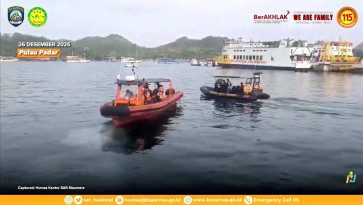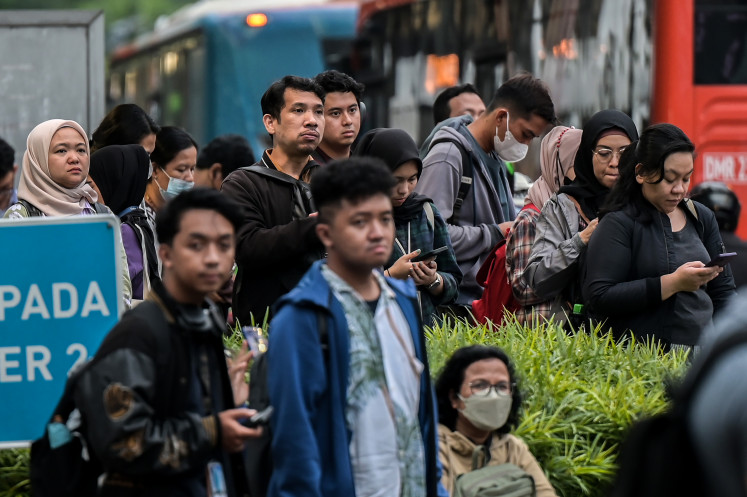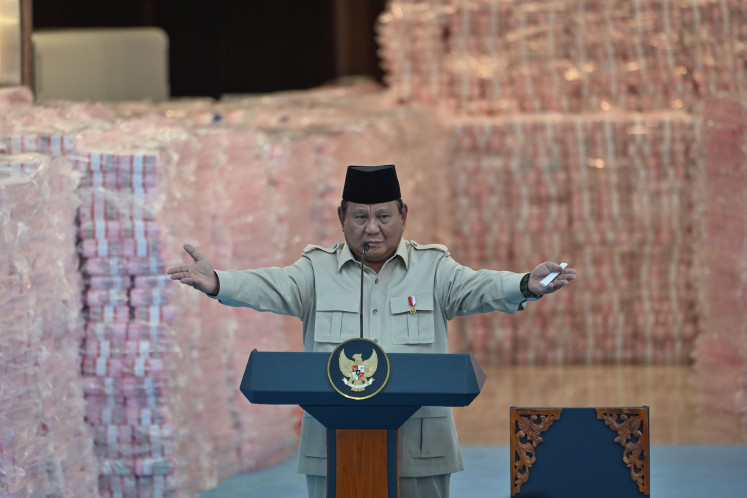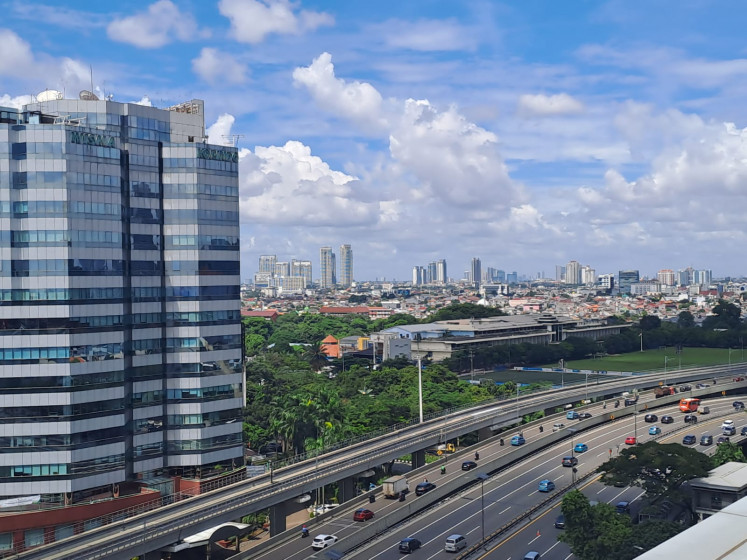Popular Reads
Top Results
Can't find what you're looking for?
View all search resultsPopular Reads
Top Results
Can't find what you're looking for?
View all search resultsEnergy ministry announces price cap for Jargas gas contractors
While a recently issued Presidential Regulation on gas supply and distribution does not set the price cap, it authorizes the Energy and Mineral Resources Minister to do so.
Change text size
Gift Premium Articles
to Anyone
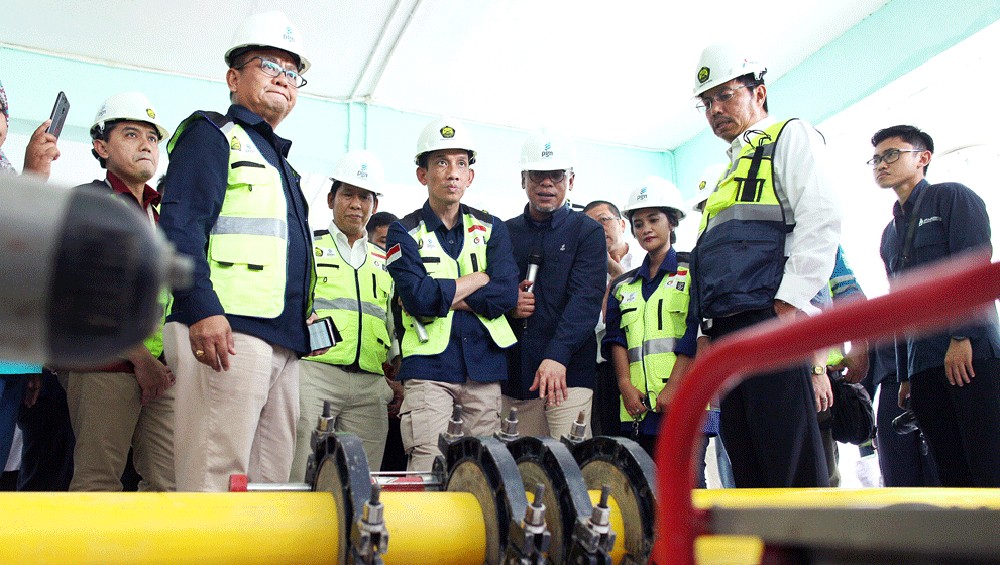 Energy officials inspect the installation of a gas pipeline on Wednesday at an apartment complex in Bom Panjang, Tarakan, North Kalimantan. Energy and Mineral Resources Deputy Minister Arcandra Tahar (fourth left), the ministry’s oil and gas infrastructure planning and development director Alimuddin Baso (third left), PGN infrastructure and technology director Dilo Seno Widagdo (fourth right), Pertamina retail marketing director Mas’ud Khamid (second right) and PGN gas network business group head M. Napitupulu (second left) attended the inspection. (Antara/Fachrurrozi)
Energy officials inspect the installation of a gas pipeline on Wednesday at an apartment complex in Bom Panjang, Tarakan, North Kalimantan. Energy and Mineral Resources Deputy Minister Arcandra Tahar (fourth left), the ministry’s oil and gas infrastructure planning and development director Alimuddin Baso (third left), PGN infrastructure and technology director Dilo Seno Widagdo (fourth right), Pertamina retail marketing director Mas’ud Khamid (second right) and PGN gas network business group head M. Napitupulu (second left) attended the inspection. (Antara/Fachrurrozi)
O
il and gas contractors (KKKS) should supply gas at a price cap of US$4.72 per million British thermal units (mmbtu) to accelerate the development of the household gas network (Jargas) national program, an official at the Energy and Mineral Resources Ministry has said.
“Previously, we had found that several KKKS were unwilling [to supply gas to the network], but now it is mandatory. As long as the infrastructure is available, they should supply [gas] at a maximum price of $4.72 per mmbtu,” said Alimuddin Baso, the ministry’s director of oil and gas infrastructure planning and development.
The price cap is not stipulated in the newly issued Presidential Regulation (Perpres) No.6/2019 on natural gas supply and distribution for households and small commercial consumers, effective Jan. 28.
However, the regulation stipulates that the energy minister is responsible for setting the price cap based on three requisites: the gas price should be calculated from the wellhead; the gas supply should be uninterrupted; and the gas distribution should be free from additional schemes like take-or-pay, standby letters of credit and price escalation.
Indonesian Petroleum Association (IPA) president Tumbur Parlindungan said the price cap should not be a problem for contractors as long as they had available supplies of gas, and that the commercial aspects could be discussed with the government later.
“Usually the gas price is set in accordance with the market price. […] We have yet to be informed about the gas price cap of $4.72 per mmbtu, but this shouldn’t be a problem, as the gas volume [of the national network] is small,” he told The Jakarta Post recently.
Alimuddin said the new regulation also provided opportunities for gas distributors to join the Jargas network, but that they should partner with the government.
“The government will set the gas [capacity] allocation, but the companies should finance [the network],” he said. “We will offer them incentives, such as special prices for household consumers and small [commercial consumers].”
Alimuddin added that gas distributors would also be freed of all costs related to the existing gas infrastructure, like network fees.
From its 2009 launch through to 2017, the Jargas network has connected 235,935 households across 31 regions. The network connected an additional 89,906 consumers in 18 locations last year.
The government expects to connect almost 5 million households to the national network by 2025.
Alimuddin said the state budget could fund only 125,000 connections, while gas distributors were expected to finance the rest.
He believed that the new policy would succeed, as the national program only required a small volume of gas to be supplied to the network – from 0.1 million standard cubic feet per day (mmscfd) to 0.2 million mmscfd – which was lower than the contractors' total production output.
At such a small supply volume, Alimuddin said that the Jargas program was intended to be “just like a CSR [corporate social responsibility]" for KKKS, while contributing to the government's efforts to reduce imports of liquefied petroleum gas (LPG).
The high volume of imported LPG was one of the reasons the government came up with the Jargas network program. More than half of the national gas demand of 6.5 million metric tons was still imported.
The government has been distributing subsidized 3-kilogram LPG canisters for more than a decade. These canisters, popularly called “LPG melons” because of their bright green color, are used primarily by lower-income residents for cooking.
However, the subsidized LPG program is tainted with reports of expensive end-user prices.
The House of Representatives recently grilled the government on its failure to maintain the set price of Rp 12,750 (91 US cents) for each 3-kg canister of subsidized LPG.
Experts have also pointed out that the national gas network still had limited coverage, so people in remote, unconnected regions would still choose to purchase the subsidized LPG as a more cost-efficient option.
Pri Agung Rakhmanto, a researcher at Jakarta-based energy think tank ReforMiner Institute, said the Jargas program could succeed if the government could ensure national expansion that involved all major KKKS.
“It should be a nationwide program, not just a program of related ministries,” he said, pointing out that if the network was limited to only one or two areas or was intermittent, "then the prospective contractors would be limited to those areas”.
As for the price cap, Pri Agung concurred that $4.72 per mmbtu was sufficiently competitive and would not incur losses for gas contractors.
Meanwhile, state-owned gas giant PGN said it had partnered with two KKKS that would use its Duri-Dumai gas pipeline to support the Jargas program. The pipeline runs from ConocoPhillips’ Corridor Block in South Sumatra and the Merang Block in Jambi, and is under the management of state-owned oil and gas holding company Pertamina.
PGN infrastructure and technology director Dilo Seno Widagdo said that potential gas customers included not only industrial consumers like petrochemical and oleochemical producers, but also households.
“We estimate that around 200 households will be connected to the national program,” he said.


